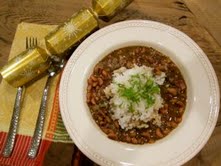Black Eyed Peas : Local, Global, Real Food
On New Year’s Day, I celebrated an age-old but new to me custom of eating black eyed peas with rice to ensure good luck throughout the new year.
Our hostess Debbie Gerber, the personification of “you can take the girl out of Alabama but she’ll carry Southern graciousness with her wherever she goes” treated her guests to a full-on Southern Bayou meal beginning with West Indies Crab Salad, moving on to Fried Oysters and then Boiled Crayfish, Shrimp Gumbo and Hoppin’ John, the Bayou name for Black Eyed Peas with Rice. Desserts followed including homemade Pecan and Pumpkin Pies.
All of the food was delicious, but I admit being won over by the Hoppin’ John flavors and those distinctive, tiny black “eyes.”
Suspecting that stewed black eyed peas must be a Real Food, I borrowed one of Debbie’s old and well used Creole cookbooks, made Hoppin’ John and then set out on a black eyed pea research project.
I learned right away that they not only are one of the oldest cultivated crops known, but also that throughout the world they have been and still are a favorite culinary staple. They certainly are a Real Food.
In the coming weeks I will share several recipes that I find and test. Debbie’s Hoppin’ John recipe follows the summary of my research.
A subspecies of the Cowpea, the black eyed pea (Vigna unguiculata), is not in fact a pea. It is an enzyme and calcium rich legume that for thousands of years has been a domesticated crop in Africa, Asia, the Middle East and areas that eventually became Europe.
Black eyed peas are popular for good reasons. They grow vigorously without special care or extra irrigation in all kinds of soils that are left rich in nitrogen after harvest. They also last dried for months with nutrients safely protected inside the firm outer shell. Finally, these socially sensitive little legumes do not contain indigestible sugars and starches that cause flatulence.
In 500 CE, the Babylonian Talmud for Rosh Hashanah predicted good luck for the coming year to those who ate black eyed peas with rice on the first day of the New Year. That bit of magic stuck, and they still appear on New Years Day menus throughout the world.
As versatile as they are healthful, black eyed peas are a favored food in many cultures. In Portugal they are cooked with potato and cod in a broth called Bacalao. In Greece and Cyprus they are cooked with chard, oil and lemon juice in a stew called Louvi Me Lahana.
In Africa, India and South America they commonly are dried, rehydrated and then skinned before being made into a batter and fried, or cooked in a stew. A common West African street food called Acara (and many derivatives of the word) is a crisp fritter made with ground black eyed peas and both hot and sweet peppers.
Called Lobia In northern India, black eyed peas are dried, rehydrated and then made into Daal, a popular and versatile vegetable stew. In Vietnam, black eyed peas are combined with sticky rice and coconut milk in a sweet dessert called Chè Dau Trang.
In Brazil, a spicy fritter called Acarajé appears on street carts everywhere. The black eyed peas are ground with dried shrimp and shaped into balls that are deep fried and then filled with fresh shrimp and onion. Rehydrated and left whole, black eyed peas are the main ingredient in Salada de Feijao Verde, a popular Brazilian salad made by combining them with olives, onion, peppers and cilantro. In northern Columbia a breakfast fritter called Buñuel is made with ground black eyed peas blended with egg.
First introduced into the US in the 17th century by African slaves, black eyed peas eventually became widely used throughout the south and a lasting symbol of Creole cooking.
Soaking dried legumes activates the enzymes and extracts lectin and phthalate, improving their flavor and nutritional value. Several recipes suggest soaking the dried “peas” in 3-4 hour stages, changing the water after each period and bringing the new water to a low boil, then taking it off the heat for the next stage. Others suggest rinsing them well, soaking them once over night and rinsing them again before cooking. After 8-12 hours in water, dried black eyed peas will be sufficiently soft to cook in stews or roast.
Hints
1. Instead of throwing out the nutrient rich soaking water, pour it on your plants; they’ll love it.
2. Always look through dried legumes and pick out any rocks or obviously ruined legumes.
Editor’s note: Hoppin’ John recipe to follow.


Pingback: Tweets that mention Black Eyed Peas : Local, Global Real Food | Fresh by Northwest -- Topsy.com